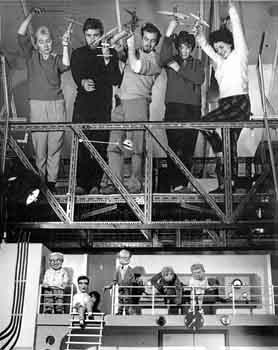The
birth of the independent television network in 1955 changed
the face of British broadcasting like no other television event,
before or since. Not only did it unleash a model of commercial
TV broadcasting that still exists today, it also spawned a raft
of small, independent production companies that helped feed
the voracious appetite of the new broadcaster.
One
such company was AP Films which was formed in 1956 by Gerry
Anderson, Arthur Provis, Sylvia (Thamm/Anderson), Reg Hill
and John Read. The fledgling outfit set up offices in Islet
Park in Maidenhead, overlooking the Thames, but the expected
offers of work failed materialised. Bankruptcy loomed.
Eleventh
hour salvation arrived in the form of an offer from Roberta
Lee. The writer was looking for a production company to film
52 fifteen-minute scripts about a toy character she had created
called Twizzle. There was, however, one drawback - Twizzle
[1956 - 52 episodes] was to be a puppet show.
This
was not exactly what the staff at AP Films had in mind when
they set up the company but despite their reluctance there
were mounting bills to pay. So, with was no other source of
income in sight, the deal was signed. And to everyone's surprise
the show was a success. This led to a further puppet production
with Lee, Torchy the Battery Boy (1957 - 52 episode)] which
also captured a healthy audience.
AP
Films went on to develop its own show with the Western adventure
Four Feather Falls [1958 - 39 episodes] but it would be the
company's fourth production, Supercar, that would ensure its
future.
Despite
the success of the puppet shows Gerry Anderson didn't feel
that his fledgling production company was fulfilling its true
potential: "The fact we were filming with these awful creatures
made me desperate. I wanted to make big pictures like Ben
Hur."
Generally
regarded as the first classic AP films puppet series, Supercar
[1959 - 39 episodes] almost never made it beyond its maiden
flight. Making the show's pilot episode drained the tiny company's
limited financial reserves but because of the proposed budget,
Granada, the company's previous backer, declined Supercar
on the grounds that it was too expensive a production for
its proposed audience.
Just
as it looked like everything was lost Lew Grade, the head
of ATV, stepped forward and offered to bankroll the series
- things would never look the same again for the small production
company. Soon AP Films was moving into new premises but more
importantly, Supercar made it onto the American TV network,
NBC.
The
show was a simple adventure series about pilot Mike Mercury
and his amazing flying car, the eponymous Supercar, which
also doubled as a submarine and spaceship. His heroic efforts
were ably supported by Professor Popkiss and Doctor Beaker,
and the ten-year-old Jimmy Gibson and his pet monkey Mitch.
It
was surprisingly sophisticated fare by the standards of its
day and effectively created the blueprint for the puppet shows
that were to follow, especially the decision to focus the
action around a flying craft. The serendipitous idea was originally
conceived as a way of moving the puppets around without the
need for them to walk but it soon became clear that Supercar
was as much the star of the show as Mike Mercury.
"I
was stuck with puppets that couldn't even walk, let alone
run, and I was faced with having to find a way of achieving
even faster movement," said Gerry Anderson. That solution
was a flying car.
The
show was a massive hit but this success also created problems.
Whatever followed Supercar would have to better. Fortunately,
Fireball XL5 superseded its super predecessor both technically
and in terms of popularity.
Anthony
Clark

Return
to...

|